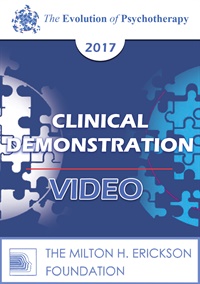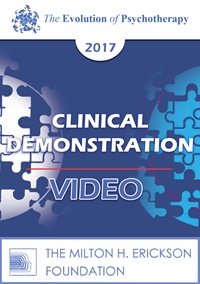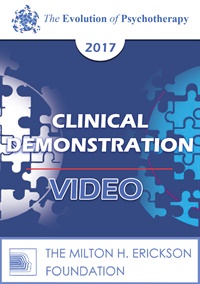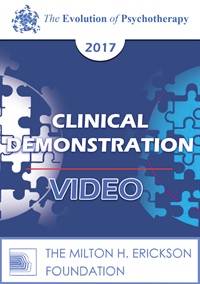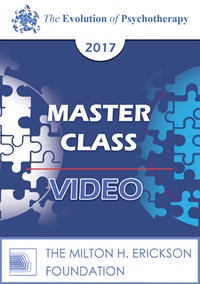Credit available - Click Here for more information
- Average Rating:
- Not yet rated
- Topic Areas:
- Clinical Demonstrations | Hypnosis | Psychotherapy
- Bundle(s):
- Learning Track - EP17 Erickson Stream
- Categories:
- Evolution of Psychotherapy | Evolution of Psychotherapy 2017 | Evolution of Psychotherapy Erickson Learning Track | Online Continuing Education
- Faculty:
- Michael Yapko, PhD
- Course Levels:
- Master Degree or Higher in Health-Related Field
- Duration:
- 56:19
- Format:
- Audio and Video
- Original Program Date:
- Dec 15, 2017
- Short Description:
- In this live demonstration, hypnosis becomes a catalyst for empowerment as a participant explores her struggles with emotional eating. Through guided imagery and focused attention, she discovers how aligning self-worth with her values and mission can reshape choices in everyday life. The session shows how hypnosis helps clients access inner strengths, reframe impulses, and walk away with a deeper sense of agency.
- Price:
-
Sale is $29.00
price reduced from Base Price - $59.00
Credit available - Click Here for more information
- Average Rating:
- Not yet rated
- Topic Areas:
- Clinical Demonstrations with Discussant | Emotionally Focused Therapy (EFT) | Generative Psychotherapy | Art and Creativity | Goals of the Therapist | Psychotherapy
- Bundle(s):
- Learning Track - EP17 Erickson Stream
- Categories:
- Evolution of Psychotherapy | Evolution of Psychotherapy 2017 | Evolution of Psychotherapy Erickson Learning Track | Online Continuing Education
- Faculty:
- Stephen Gilligan, PhD | Sue Johnson, EdD
- Course Levels:
- Master Degree or Higher in Health-Related Field
- Duration:
- 1:27:23
- Format:
- Audio and Video
- Original Program Date:
- Dec 14, 2017
- Short Description:
- This demonstration will show how activating a client’s creative process is the key factor in generative psychotherapy. This process follows four steps: 1) Identifying a goal (A positive change or transforming a negative pattern), 2) Developing a generative state, 3) Utilizing the generative state to creatively achieve the goal, and 4) Guiding the session changes into real life achievement.
- Price:
- $0.00 - $29.00
Credit available - Click Here for more information
- Average Rating:
- Not yet rated
- Topic Areas:
- Clinical Demonstrations with Discussant | Psychotherapy | Evocative Communication | Brief Therapy | Ericksonian Psychotherapy | Ericksonian Hypnosis and Therapy Techniques | Experiential Therapy | Strategic Therapy
- Bundle(s):
- Learning Track - EP17 Erickson Stream
- Categories:
- Evolution of Psychotherapy | Evolution of Psychotherapy 2017 | Evolution of Psychotherapy Erickson Learning Track | Online Continuing Education
- Faculty:
- Jeffrey Zeig, PhD | Otto Kernberg, MD
- Course Levels:
- Master Degree or Higher in Health-Related Field
- Duration:
- 1:24:21
- Format:
- Audio and Video
- Original Program Date:
- Dec 14, 2017
- Short Description:
- Experiential components central to brief, strategic approaches to psychotherapy. We will compare and contrast Ericksonian and psychodynamic perspectives.
- Price:
-
Sale is $29.00
price reduced from Base Price - $59.00
Credit available - Click Here for more information
- Average Rating:
- Not yet rated
- Topic Areas:
- Clinical Demonstrations with Discussant | Neuro-Linguistic Programming (NLP) | Psychotherapy | Relationships
- Bundle(s):
- Learning Track - EP17 Erickson Stream
- Categories:
- Evolution of Psychotherapy | Evolution of Psychotherapy 2017 | Evolution of Psychotherapy Erickson Learning Track | Online Continuing Education
- Faculty:
- Robert Dilts, BA | Michael Yapko, PhD
- Course Levels:
- Master Degree or Higher in Health-Related Field
- Duration:
- 1:24:12
- Format:
- Audio and Video
- Original Program Date:
- Dec 14, 2017
- Short Description:
- This demonstration explores how shifting attention between foreground and background perceptions can unlock new resources for clients who feel stuck. Through a live session, a participant grapples with a lifelong sense of “invisibility,” discovering how subtle changes in awareness and bodily cues create greater presence and self-trust. The process illustrates how experiential techniques can transform limiting patterns into empowerment and visibility.
- Price:
-
Sale is $29.00
price reduced from Base Price - $59.00
Credit available - Click Here for more information
- Average Rating:
- Not yet rated
- Topic Areas:
- Clinical Demonstrations with Discussant | Psychotherapy | Hypnosis | Therapist Development
- Bundle(s):
- Learning Track - EP17 Erickson Stream
- Categories:
- Evolution of Psychotherapy | Evolution of Psychotherapy 2017 | Evolution of Psychotherapy Erickson Learning Track | Online Continuing Education
- Faculty:
- Ernest Rossi, PhD | Kathryn Rossi, PhD | Jean Houston, PhD
- Course Levels:
- Master Degree or Higher in Health-Related Field
- Duration:
- 1:31:30
- Format:
- Audio and Video
- Original Program Date:
- Dec 14, 2017
- Short Description:
- In a 1964/2008 paper MHE documented how "hypnosis was used for the specific purpose of placing the burden of responsibility for therapeutic results upon the patient himself after he reached a definite conclusion that therapy would not help and that a last resort would be a hypnotic 'miracle'.” I will first demonstrate how to gently shift this "burden of responsibility for therapeutic results" in a brief, easy-to-learn group process with the entire audience. Time permitting, anyone who feels they have failed during this group process may volunteer for a therapeutic experience with me in front of the entire audience.
- Price:
-
Sale is $29.00
price reduced from Base Price - $59.00
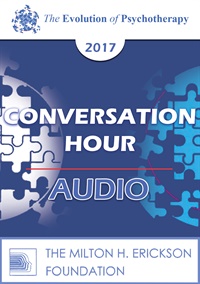
- Average Rating:
- Not yet rated
- Topic Areas:
- Conversation Hours | Generative Psychotherapy | Psychotherapy | Art and Creativity
- Bundle(s):
- Learning Track - EP17 Erickson Download
- Categories:
- Evolution of Psychotherapy | Evolution of Psychotherapy 2017 | Evolution of Psychotherapy Erickson Learning Track
- Faculty:
- Stephen Gilligan, PhD
- Course Levels:
- Master Degree or Higher in Health-Related Field
- Duration:
- 59:52
- Format:
- Audio Only
- Original Program Date:
- Dec 15, 2017
- Short Description:
- Dr. Gilligan will briefly overview his general approach to the creative process of effective psychotherapy, and then open the floor to conversation from participants.
- Price:
- $15.00 - Base Price
Credit available - Click Here for more information
- Average Rating:
- Not yet rated
- Topic Areas:
- Great Debates | Cognitive Behavior Therapy (CBT) | Experiential Therapy | Psychotherapy
- Bundle(s):
- Learning Track - EP17 CBT Stream | Learning Track - EP17 Erickson Stream
- Categories:
- Evolution of Psychotherapy | Evolution of Psychotherapy 2017 | Evolution of Psychotherapy CBT Learning Track | Evolution of Psychotherapy Erickson Learning Track | Online Continuing Education
- Faculty:
- Stephen Gilligan, PhD | Donald Meichenbaum, PhD
- Course Levels:
- Master Degree or Higher in Health-Related Field
- Duration:
- 1:19:30
- Format:
- Audio and Video
- Original Program Date:
- Dec 14, 2017
- Short Description:
- This exchange will focus on the classic question of whether good therapy should focus more on cognitive or experiential changes. The merits of each, and the possibility of a “both/and” partnership, are considered.
- Price:
-
Sale is $29.00
price reduced from Base Price - $59.00
Credit available - Click Here for more information
- Average Rating:
- Not yet rated
- Topic Areas:
- Master Classes | Psychotherapy | Experiential Therapy | Gestalt | Hypnosis
- Bundle(s):
- Learning Track - EP17 Erickson Stream | Learning Track - EP17 Psychotherapy Stream
- Categories:
- Evolution of Psychotherapy | Evolution of Psychotherapy 2017 | Evolution of Psychotherapy Erickson Learning Track | Evolution of Psychotherapy Psychotherapy Learning Track | Online Continuing Education
- Faculty:
- Erving Polster, PhD | Jeffrey Zeig, PhD
- Course Levels:
- Master Degree or Higher in Health-Related Field
- Duration:
- 1:24:19
- Format:
- Audio and Video
- Original Program Date:
- Dec 18, 2017
- Short Description:
- Part 1 of 3. Gestalt therapy and Ericksonian hypnotherapy are experiential methods of change. In combination they can be synergistic. Psychotherapy is best when clients have a first-hand experience of an alive therapeutic process. Such dynamic empowering experiences pave the way for dynamic understandings. Drs. Polster and Zeig will engage with each other and the participants to examine commonalities and differences in their work.
- Price:
-
Sale is $29.00
price reduced from Base Price - $59.00
Credit available - Click Here for more information
- Average Rating:
- Not yet rated
- Topic Areas:
- Master Classes | Psychotherapy | Experiential Therapy | Gestalt | Hypnosis
- Bundle(s):
- Learning Track - EP17 Erickson Stream | Learning Track - EP17 Psychotherapy Stream
- Categories:
- Evolution of Psychotherapy | Evolution of Psychotherapy 2017 | Evolution of Psychotherapy Erickson Learning Track | Evolution of Psychotherapy Psychotherapy Learning Track | Online Continuing Education
- Faculty:
- Erving Polster, PhD | Jeffrey Zeig, PhD
- Course Levels:
- Master Degree or Higher in Health-Related Field
- Duration:
- 1:17:56
- Format:
- Audio and Video
- Original Program Date:
- Dec 18, 2017
- Short Description:
- Part 2 of 3. Gestalt therapy and Ericksonian hypnotherapy are experiential methods of change. In combination they can be synergistic. Psychotherapy is best when clients have a first-hand experience of an alive therapeutic process. Such dynamic empowering experiences pave the way for dynamic understandings. Drs. Polster and Zeig will engage with each other and the participants to examine commonalities and differences in their work.
- Price:
-
Sale is $29.00
price reduced from Base Price - $59.00
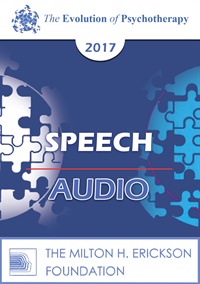
- Average Rating:
- Not yet rated
- Topic Areas:
- Speeches | Utilization | Ericksonian Hypnosis and Therapy Techniques | Hypnosis | Psychotherapy
- Bundle(s):
- Learning Track - EP17 Erickson Download
- Categories:
- Evolution of Psychotherapy | Evolution of Psychotherapy 2017 | Evolution of Psychotherapy Erickson Learning Track
- Faculty:
- Michael Yapko, PhD
- Duration:
- 1:01:15
- Format:
- Audio Only
- Original Program Date:
- Dec 15, 2017
- Short Description:
- This session looks at how hypnosis can enhance treatment by fostering focus, cognitive flexibility, and meaningful physiological change. Drawing on both clinical evidence and personal experience, Michael Yapko demystifies hypnosis and explores its value in treating pain, mood disorders, and more. Participants learn how selective attention and dissociation can be harnessed to create lasting therapeutic shifts.
- Price:
- $15.00 - Base Price
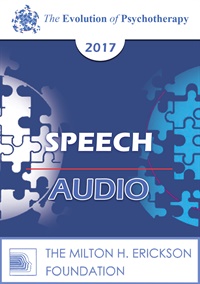
- Average Rating:
- Not yet rated
- Topic Areas:
- Speeches | Psychotherapy | Art and Creativity | Consciousness
- Bundle(s):
- Learning Track - EP17 Erickson Download
- Categories:
- Evolution of Psychotherapy | Evolution of Psychotherapy 2017 | Evolution of Psychotherapy Erickson Learning Track
- Faculty:
- Ernest Rossi, PhD | Kathryn Rossi, PhD
- Duration:
- 1:00:52
- Format:
- Audio Only
- Original Program Date:
- Dec 16, 2017
- Short Description:
- An Introduction to the facts and fallacies of how the Quantum World View could facilitate the Evolution of Psychotherapy by integrating the best insights of the arts, humanities and sciences to support people, cultures and nations to become the best they can be.
- Price:
- $15.00 - Base Price
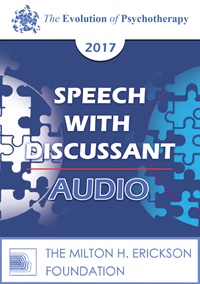
- Average Rating:
- Not yet rated
- Topic Areas:
- Speeches with Discussants | Psychotherapy | Art and Creativity | Experiential Therapy | Therapist Development
- Bundle(s):
- Learning Track - EP17 Erickson Download
- Categories:
- Evolution of Psychotherapy | Evolution of Psychotherapy 2017 | Evolution of Psychotherapy Erickson Learning Track
- Faculty:
- Stephen Gilligan, PhD | Jean Houston, PhD
- Duration:
- 1:28:43
- Format:
- Audio Only
- Original Program Date:
- Dec 16, 2017
- Short Description:
- Therapy is successful when clients are able to experientially realize positive life changes. While the identification and transformation of symptoms is important in this regard, the activation of the client's creative capacity to change is even more important. This paper outlines 6 steps in this therapeutic process:: (1) opening a mindful field, (2) setting positive intentions, (3) developing and maintaining a creative state, (4) identifying a “storyboard” for achieving goals, (5) transforming negative experiences, and (6) everyday practices Methods and case examples will be given to illuminate this core process.
- Price:
- $15.00 - Base Price
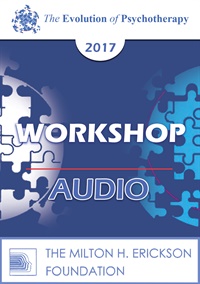
- Average Rating:
- Not yet rated
- Topic Areas:
- Workshops | Consciousness | Binds | Art and Creativity | Ericksonian Hypnosis and Therapy Techniques | Psychotherapy
- Bundle(s):
- Learning Track - EP17 Erickson Download
- Categories:
- Evolution of Psychotherapy | Evolution of Psychotherapy 2017 | Evolution of Psychotherapy Erickson Learning Track
- Faculty:
- Ernest Rossi, PhD | Kathryn Rossi, PhD
- Duration:
- 2:38:21
- Format:
- Audio Only
- Original Program Date:
- Dec 13, 2017
- Short Description:
- MHE's 1965 paper "A Special Inquiry with Aldous Huxley into the Nature and Character of Various States of Consciousness" will be used so everyone can experience their personal version of Deep Reflection, the Double Dissociation Double Bind and the Quantum Qualia of their private consciousness and cognition for facilitating gene expression and brain plasticity to optimize their own growing edges.
- Price:
- $15.00 - Base Price
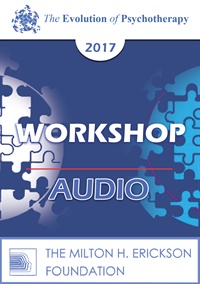
- Average Rating:
- Not yet rated
- Topic Areas:
- Workshops | Psychotherapy | Ericksonian Hypnosis and Therapy Techniques | Strategic Therapy
- Bundle(s):
- Learning Track - EP17 Erickson Download
- Categories:
- Evolution of Psychotherapy | Evolution of Psychotherapy 2017 | Evolution of Psychotherapy Erickson Learning Track
- Faculty:
- Michael Yapko, PhD
- Duration:
- 2:21:55
- Format:
- Audio Only
- Original Program Date:
- Dec 13, 2017
- Short Description:
- This workshop explores how hypnosis can sharpen clients’ ability to distinguish between perceptions, feelings, and facts—an essential foundation for sound decision making. Through demonstration and discussion, it shows how refined discrimination skills help clients recognize options, reduce emotional reactivity, and make wiser life choices. Participants learn practical hypnotic methods for teaching discernment, fostering insight, and strengthening judgment in everyday situations.
- Price:
- $15.00 - Base Price
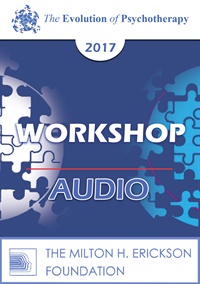
- Average Rating:
- Not yet rated
- Topic Areas:
- Workshops | Psychotherapy | Positive Psychology | Psychology
- Bundle(s):
- Learning Track - EP17 Erickson Download
- Categories:
- Evolution of Psychotherapy | Evolution of Psychotherapy 2017 | Evolution of Psychotherapy Erickson Learning Track
- Faculty:
- Stephen Gilligan, PhD
- Course Levels:
- Master Degree or Higher in Health-Related Field
- Duration:
- 2:01:32
- Format:
- Audio Only
- Original Program Date:
- Dec 13, 2017
- Short Description:
- A central currency in the therapeutic exchange is negative experiences--depression, anxiety, trauma, addiction, etc. This practical and positive approach assumes that each core human experience has equivalent potential to be positive or negative, depending on the human relationship to it; and thus focuses on how problems may be transformed to resources by skillful human connection. This process operates at two levels: (1) developing a generative state (in the therapist, client, and relationship field) and then (2) using specific methods of transforming negative experiences and behaviors. Multiple techniques and examples for will be given, along with an exercise and demonstration.
- Price:
- $15.00 - Base Price
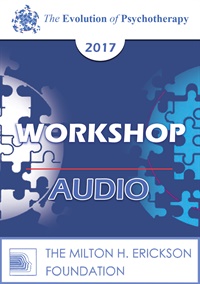
- Average Rating:
- Not yet rated
- Topic Areas:
- Workshops | Neuroscience | Neurobiology | Ericksonian Hypnosis and Therapy Techniques | Experiential Therapy
- Bundle(s):
- Learning Track - EP17 Erickson Download
- Categories:
- Evolution of Psychotherapy | Evolution of Psychotherapy 2017 | Evolution of Psychotherapy Erickson Learning Track
- Faculty:
- Ernest Rossi, PhD | Kathryn Rossi, PhD
- Duration:
- 2:48:35
- Format:
- Audio Only
- Original Program Date:
- Dec 17, 2017
- Short Description:
- In this experiential workshop, we will learn the theory and practice of methods evolved out of Milton H Erickson’s innovative approaches to therapeutic hypnosis as presented in our new book. These easy-to-learn methods can facilitate Erickson’s natural problem solving and MindBody Healing that can supplement CBT, mindfulness, meditation, movement, and yoga.
- Price:
- $15.00 - Base Price
Credit available - Click Here for more information
- Average Rating:
- Not yet rated
- Topic Areas:
- Workshops | Experiential Therapy | Metaphors | Psychotherapy | Therapist Development | Evocative Communication
- Bundle(s):
- Learning Track - EP17 Erickson Stream
- Categories:
- Evolution of Psychotherapy | Evolution of Psychotherapy 2017 | Evolution of Psychotherapy Erickson Learning Track | Online Continuing Education
- Faculty:
- Jeffrey Zeig, PhD
- Course Levels:
- Master Degree or Higher in Health-Related Field
- Duration:
- 2:20:46
- Format:
- Audio and Video
- Original Program Date:
- Dec 17, 2017
- Short Description:
- Patients change by virtue of the experiences that they live. Therapists can use advanced techniques including verbal and physical metaphors. Lecture, demonstration and practice.
- Price:
-
Sale is $29.00
price reduced from Base Price - $59.00
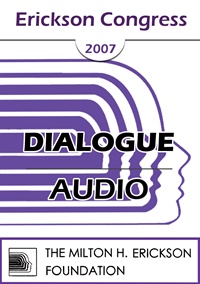
- Average Rating:
- Not yet rated
- Topic Areas:
- Dialogues | Milton Erickson | Ericksonian Psychotherapy
- Categories:
- Erickson Congress | Erickson Congress 2007
- Faculty:
- Marilia Baker, MSW | Dan Short, PhD | Alexander Simpkins, PhD | Annellen M. Simpkins, PhD
- Duration:
- 57:57
- Format:
- Audio Only
- Original Program Date:
- Dec 08, 2007
- Short Description:
- This dialogue offers a rare, personal look at Milton Erickson through the voices of students, scholars, and colleagues who knew his work intimately. Stories of self-hypnosis, teaching moments, clinical encounters, and everyday interactions reveal how Erickson’s presence shaped not just technique, but character, curiosity, and confidence. The conversation invites therapists to reflect on how Ericksonian thinking lives on through attitude, attention, and the quiet ways change takes root.
- Price:
- $15.00 - Base Price


